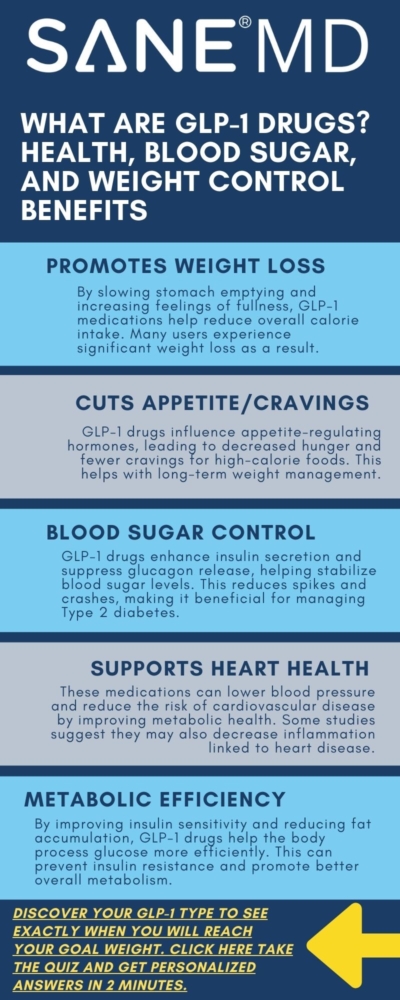What Are GLP-1 Drugs? Uses for Weight Loss & Diabetes
Dr. Matthew Olesiak, MD, is the Chief Medical Director at SANESolution, a renowned wellness technology company dedicated to providing evidence-based solutions for optimal living. Dr. Olesiak earned his medical degree from the prestigious Jagiellonian University Medical College in Kraków, Poland, where he developed a strong foundation in medicine.
Glucagon-like peptide-1 (GLP-1) receptor agonists are a class of medications primarily used to manage type 2 diabetes mellitus and, more recently, to aid in weight loss. GLP-1 medications mimic the action of the natural GLP-1 hormone, enhancing insulin secretion, suppressing glucagon release, and slowing gastric emptying, thereby helping to regulate blood sugar levels and reduce appetite. But what are GLP-1 drugs?
Key Takeaways:
- Dual Benefits: GLP-1 receptor agonists effectively lower blood sugar levels and promote weight loss, making them valuable for individuals with type 2 diabetes and those seeking weight management solutions.
- Mechanism of Action: By mimicking the GLP-1 hormone, these medications enhance insulin secretion, suppress glucagon release, and slow gastric emptying, leading to improved blood glucose control and reduced appetite.
- Considerations: While beneficial, GLP-1 receptor agonists may have side effects and are not suitable for everyone. Consultation with a healthcare professional is essential to determine appropriateness and monitor for potential adverse effects.
Understanding GLP-1 Receptor Agonists
GLP-1 receptor agonists, also known as incretin mimetics, are a class of medications that replicate the activity of the glucagon-like peptide-1 (GLP-1) hormone. This hormone is naturally produced in the intestines and plays a crucial role in regulating glucose metabolism. When food is consumed, GLP-1 is secreted and stimulates insulin release from the pancreas. At the same time, it inhibits glucagon secretion, which prevents the liver from producing excess glucose. Additionally, GLP-1 slows gastric emptying, which prolongs digestion and contributes to a feeling of fullness, reducing overall food intake.
These combined actions help lower blood sugar levels and promote satiety, making GLP-1 receptor agonists effective in managing type 2 diabetes and aiding weight loss. Due to their ability to control blood sugar while also addressing obesity, these drugs have gained significant attention in recent years.
Comparison of FDA-Approved GLP-1 Receptor Agonists
| Drug Name | Brand Names | Dosing Schedule | Primary Use | Additional Benefits |
|---|---|---|---|---|
| Exenatide | Byetta, Bydureon | Byetta: Twice daily Bydureon: Once weekly |
Type 2 Diabetes | Modest weight loss |
| Liraglutide | Victoza, Saxenda | Victoza: Daily Saxenda: Daily (higher dose) |
Type 2 Diabetes (Victoza) Weight Loss (Saxenda) |
Cardiovascular benefits |
| Dulaglutide | Trulicity | Once weekly | Type 2 Diabetes | Cardiovascular benefits |
| Semaglutide | Ozempic, Wegovy, Rybelsus | Ozempic: Weekly Wegovy: Weekly (higher dose) Rybelsus: Daily (oral) |
Type 2 Diabetes (Ozempic, Rybelsus) Weight Loss (Wegovy) |
Significant weight loss |
| Tirzepatide | Mounjaro, Zepbound | Once weekly | Type 2 Diabetes (Mounjaro) Weight Loss (Zepbound) |
Dual GLP-1/GIP action Greater weight loss potential |
| Lixisenatide | Adlyxin | Once daily | Type 2 Diabetes | Less commonly prescribed |
Mechanism of Action
Upon administration, GLP-1 receptor agonists bind to GLP-1 receptors in the pancreas, enhancing insulin secretion in response to elevated blood glucose levels. This action is glucose-dependent, meaning that insulin is only released when blood sugar is high, reducing the risk of hypoglycemia.
These medications also suppress the release of glucagon, a hormone that increases blood sugar levels by promoting glucose production in the liver. By inhibiting glucagon secretion, GLP-1 receptor agonists help keep blood sugar levels stable, particularly after meals.
Another key mechanism is the slowing of gastric emptying. When food takes longer to pass from the stomach to the intestines, glucose is absorbed more gradually, leading to a more controlled rise in blood sugar. This delayed gastric emptying also increases feelings of fullness, reducing appetite and caloric intake, which supports weight loss.
Furthermore, GLP-1 receptor agonists act on receptors in the brain that regulate hunger and satiety. By influencing these neural pathways, these drugs help decrease food cravings and prevent overeating, making them a valuable tool for obesity management for compatible individuals.
GLP-1 Drugs and Their Impact on Other Health Conditions
In addition to their benefits for diabetes and weight loss, GLP-1 receptor agonists have shown promise in improving other health conditions, including kidney disease, heart disease, liver health, and neurological disorders.
- Kidney Disease: GLP-1 receptor agonists may help protect kidney function by reducing inflammation, lowering blood sugar, and improving blood pressure regulation. Studies suggest that these medications can slow the progression of chronic kidney disease (CKD) in individuals with type 2 diabetes, reducing the risk of kidney failure.
- Heart Disease & Cardiovascular Events: Clinical trials have demonstrated that GLP-1 receptor agonists reduce the risk of major cardiovascular events, such as heart attacks, strokes, and heart failure. This cardiovascular protection is particularly beneficial for individuals with type 2 diabetes, who are at a higher risk of developing heart disease.
- Liver Health: Research indicates that GLP-1 receptor agonists may play a role in treating non-alcoholic fatty liver disease (NAFLD) by reducing liver fat accumulation and inflammation. Since NAFLD is often associated with obesity and insulin resistance, GLP-1 drugs’ weight loss and glucose-lowering effects may help mitigate the condition.
- Neurological Effects: Preliminary research suggests that GLP-1 receptor agonists may have neuroprotective benefits. Some studies indicate potential roles in reducing the risk of neurodegenerative diseases such as Alzheimer’s and Parkinson’s. The mechanisms behind these benefits are still being explored, but they may be linked to the drugs’ anti-inflammatory and metabolic effects.
Approved GLP-1 Receptor Agonists
Several GLP-1 receptor agonists have received FDA approval for use in managing type 2 diabetes and weight loss. Each drug differs slightly in its dosing schedule, duration of action, and effectiveness.
- Exenatide (Byetta, Bydureon): Exenatide was one of the first GLP-1 receptor agonists approved for diabetes treatment. Byetta requires twice-daily injections, while Bydureon is an extended-release formulation that is injected once weekly. Both help regulate blood sugar and offer modest weight loss benefits.
- Liraglutide (Victoza, Saxenda): Victoza is a daily injectable GLP-1 agonist approved for type 2 diabetes. A higher-dose formulation, Saxenda, is FDA-approved for chronic weight management, helping patients achieve meaningful weight loss when combined with diet and exercise.
- Dulaglutide (Trulicity): A once-weekly injectable medication, dulaglutide improves blood sugar control and has been associated with cardiovascular benefits in individuals with type 2 diabetes.
- Semaglutide (Ozempic, Wegovy, Rybelsus): Ozempic is a once-weekly injectable medication for diabetes, while Wegovy is a higher-dose version approved for weight management. Rybelsus is the first oral GLP-1 receptor agonist, offering a non-injectable option for patients with type 2 diabetes.
- Tirzepatide (Mounjaro, Zepbound) – Though technically a dual GLP-1/GIP receptor agonist, tirzepatide is often grouped with GLP-1 drugs. In case you’re wondering, Zepbound is not the same as Mounjaro. Mounjaro is FDA-approved for type 2 diabetes, while Zepbound, its higher-dose version, is approved for weight loss. Unlike traditional GLP-1 drugs, tirzepatide also activates GIP (glucose-dependent insulinotropic polypeptide) receptors, which may enhance insulin secretion, improve metabolic function, and lead to more significant weight loss than semaglutide.
- Lixisenatide (Adlyxin): This once-daily injectable GLP-1 receptor agonist is primarily used for blood sugar control in type 2 diabetes but is not widely prescribed compared to newer alternatives.
Each of these drugs mimics the natural GLP-1 hormone, providing benefits such as improved glycemic control, weight loss, and cardiovascular protection. If you’ve been wondering what’s the best GLP-1 drug, let us help you out with our comprehensive article, “Ozempic vs. Wegovy vs. Mounjaro vs. Zepbound.”
How GLP-1 Drugs Compare to Other Diabetes Medicines
GLP-1 receptor agonists are one of several drug classes used to manage type 2 diabetes. Compared to other treatments, they offer unique benefits and potential drawbacks.
- SGLT2 Inhibitors (e.g., Jardiance, Farxiga): Unlike GLP-1 receptor agonists, SGLT2 inhibitors work by preventing the kidneys from reabsorbing glucose, leading to its excretion through urine. While both classes lower blood sugar, GLP-1 receptor agonists are more effective in reducing appetite and promoting weight loss.
- DPP-4 Inhibitors (e.g., Januvia, Tradjenta): These drugs help increase GLP-1 levels naturally but are generally less effective than GLP-1 receptor agonists. They also do not promote weight loss to the same extent.
- Metformin: A first-line treatment for type 2 diabetes, metformin primarily reduces glucose production in the liver. While it can aid modest weight loss, it does not provide the same appetite-suppressing benefits as GLP-1 receptor agonists.
- Insulin: While insulin is crucial for individuals with advanced diabetes, it can sometimes lead to weight gain. GLP-1 receptor agonists provide an alternative for managing blood sugar with a lower risk of weight gain and hypoglycemia.
Choosing between these treatments depends on the patient’s health conditions, goals, and risk factors. Many individuals benefit from a combination of therapies.
How GLP-1 Drugs Compare to Other FDA-Approved Weight Loss Treatments
GLP-1 agonists for weight loss are not the only FDA-approved treatments available to treat obesity and weight loss. Other medications and surgical options exist, each with different mechanisms of action and effectiveness.
- Other FDA-Approved Weight Loss Medications:
- Phentermine (Adipex-P, Lomaira): A stimulant that suppresses appetite and is approved for short-term use. Unlike GLP-1 receptor agonists, phentermine does not regulate blood sugar or provide long-term benefits.
- Orlistat (Alli, Xenical): A lipase inhibitor that prevents fat absorption in the intestines. While effective in some cases, it does not impact appetite regulation like GLP-1 receptor agonists.
- Naltrexone/Bupropion (Contrave): A combination drug that affects appetite and cravings. It may not be as effective for blood sugar control as GLP-1 receptor agonists.
- Phentermine/Topiramate (Qsymia): A combination medication that reduces appetite and increases calorie burning, offering another option for weight loss.
- Bariatric Surgery Options:
- Gastric Bypass (Roux-en-Y): A surgical procedure that reduces stomach size and alters digestion. It typically results in substantial, more rapid weight loss than GLP-1 medications but requires lifelong dietary and lifestyle changes.
- Sleeve Gastrectomy: Reduces stomach size but keeps digestion intact. Like gastric bypass, it leads to significant weight loss but is a more invasive option compared to GLP-1 receptor agonist drugs.
- Gastric Banding: A less invasive procedure that places an adjustable band around the stomach to restrict food intake. It is generally less effective than other surgeries and GLP-1 receptor agonists.
Compared to these treatments, GLP-1 receptor agonists offer a non-invasive, pharmacological approach that provides both weight loss and glycemic control. They are particularly beneficial for certain individuals who are overweight and have type 2 diabetes or prediabetes.
However, they may not produce weight loss as rapidly as surgery, and their effects depend on continued use.
The Role of GLP-1 Drugs in Lifestyle Management
While GLP-1 therapy is highly effective for managing blood sugar and aiding weight loss, their benefits are maximized when combined with healthy lifestyle choices. Diet, exercise, and behavioral changes all play a crucial role in achieving the best outcomes for individuals taking these medications.
Dietary Considerations
A well-balanced diet can enhance the effects of GLP-1 medications by promoting better blood sugar control and optimizing weight loss. Since GLP-1 receptor agonists slow gastric emptying, eating nutrient-dense foods with adequate protein, fiber, and healthy fats can help sustain satiety and prevent overeating. Processed foods high in refined sugars and unhealthy fats should be minimized, as they can counteract the medication’s benefits and lead to blood sugar fluctuations.
Additionally, maintaining adequate hydration is essential, as some GLP-1 medications can cause mild dehydration due to their appetite-suppressing effects.
Exercise and GLP-1 Drugs
Physical activity is an important complement to GLP-1 receptor agonists, as it enhances weight loss and improves insulin sensitivity. Regular exercise helps lower blood sugar levels, reduce insulin resistance, and increase energy expenditure. Strength training, in particular, can help preserve lean muscle mass, which is important when losing weight to prevent metabolic slowdown.
A combination of aerobic activity (such as walking, cycling, or swimming) and resistance training is recommended for individuals using GLP-1 medications. Even moderate increases in daily movements, such as walking more frequently or incorporating short exercise sessions, can amplify the medication’s effects.
Behavioral Adjustments
Sustainable lifestyle changes are essential for maintaining the benefits of GLP-1 receptor agonists long-term. Because these medications help reduce food cravings and portion sizes, individuals should use this period to develop healthier eating habits, such as mindful eating and intuitive portion control. Establishing a consistent meal schedule, tracking progress, and setting realistic weight and health goals can enhance long-term success.
Additionally, addressing emotional eating triggers and stress management techniques, such as meditation or therapy, can help prevent weight regain once medication use is discontinued. By adopting long-term behavioral changes, patients can extend the benefits of GLP-1 therapy beyond their time on the medication.
Common Misconceptions and Myths About GLP-1 Drugs
Despite their increasing popularity, GLP-1 receptor agonists are often misunderstood. Misinformation can lead to unrealistic expectations or improper use, so it is important to address some common myths about these medications.
Do GLP-1 Drugs Work Without Diet and Exercise?
While GLP-1 receptor agonists are effective at promoting weight loss and improving blood sugar control, they are not a substitute for a healthy lifestyle. These medications work best when combined with proper nutrition and physical activity.
While some weight loss may occur without significant lifestyle changes, individuals who maintain a balanced diet and engage in regular exercise experience better long-term results.
Additionally, a healthy lifestyle helps prevent muscle loss, supports metabolism, and ensures that weight loss is sustainable even if the medication is discontinued.
Are GLP-1 Medications Only for Diabetes?
Initially developed for type 2 diabetes, GLP-1 receptor agonists are now widely used for weight management, even in individuals without diabetes. The FDA has approved certain GLP-1 medications, such as Wegovy and Saxenda, specifically for weight loss.
Furthermore, research is exploring their potential benefits for other conditions, such as non-alcoholic fatty liver disease (NAFLD), cardiovascular disease, and even neurodegenerative disorders. As new studies emerge, GLP-1 receptor agonists may have even broader applications beyond diabetes and obesity.
Are There Permanent Effects?
One concern many people have is whether the benefits of GLP-1 receptor agonists persist after stopping the medication. While some individuals maintain weight loss and improved blood sugar control through continued healthy habits, many experience some degree of weight regain once they stop taking the drug. This occurs because GLP-1 receptor agonists help regulate hunger hormones, and their absence can lead to increased appetite and caloric intake.
To prevent significant weight rebound, individuals should develop sustainable lifestyle habits while on the medication, including mindful eating, regular exercise, and behavioral strategies to manage cravings and portion sizes.
FAQ: Common Questions About GLP-1 Receptor Agonists
To help clarify common questions about GLP-1 receptor agonists, here are answers to frequently asked inquiries:
1. What is GLP-1 medication for weight loss?
GLP-1 medications like semaglutide (Wegovy) and liraglutide (Saxenda) are FDA-approved for weight management. They work by reducing appetite, slowing digestion, and helping individuals feel fuller for longer.
These medications have been shown to support significant weight loss when combined with a healthy diet and exercise.
2. Is GLP-1 the same as Ozempic?
GLP-1 is a class of medications, while Ozempic (semaglutide) is a specific GLP-1 receptor agonist used to treat type 2 diabetes. Ozempic helps regulate blood sugar and can also lead to weight loss.
A higher-dose version of semaglutide, Wegovy, is specifically approved for weight management.
3. Is metformin a GLP-1 drug?
Metformin is not a GLP-1 receptor agonist. It is a first-line medication for type 2 diabetes that works by decreasing liver glucose production and improving insulin sensitivity.
While metformin may cause mild weight loss, it does not act on GLP-1 receptors or significantly suppress appetite.
4. What drugs are GLP-1 agonists?
GLP-1 agonists include medications such as Byetta, Bydureon, Victoza, Saxenda, Trulicity, Ozempic, Wegovy, Adlyxin, and Rybelsus.
These drugs mimic the natural GLP-1 hormone to enhance insulin secretion, lower blood sugar, and aid in weight management.
5. Which GLP-1 agonist is best for weight loss?
Semaglutide (Wegovy) has shown the most significant weight loss results in clinical trials, with an average reduction of around 15% of body weight over 68 weeks.
Liraglutide (Saxenda) is another effective GLP-1 medication for weight loss but requires daily administration instead of weekly injections like Wegovy.
6. Is metformin a GLP-1 agonist?
Metformin belongs to the biguanide class of diabetes medications, not the GLP-1 receptor agonists.
While it improves blood sugar control, it does not mimic GLP-1 or have the same appetite-suppressing effects as GLP-1 drugs.
Conclusion
GLP-1 receptor agonists have transformed the management of type 2 diabetes and obesity, offering a dual benefit of improved blood sugar control and significant weight loss. These medications work by mimicking the natural GLP-1 hormone, enhancing insulin secretion, slowing digestion, and reducing appetite.
Compared to other diabetes medications, GLP-1 receptor agonists provide weight loss advantages without the high risk of hypoglycemia. They also offer a non-invasive alternative to bariatric surgery for weight management. While effective, these drugs may have side effects such as nausea and require ongoing use for sustained benefits.
As research continues, newer formulations and combination therapies are being developed, further expanding the role of GLP-1 receptor agonists in managing metabolic health. Patients considering these medications should consult a healthcare provider to determine the best option for their individual needs.





